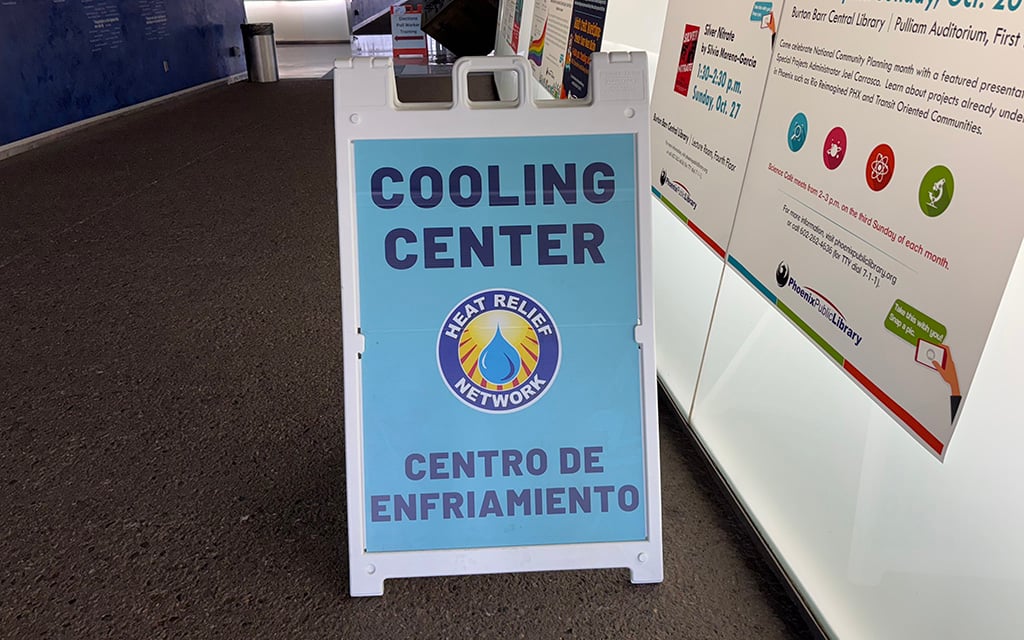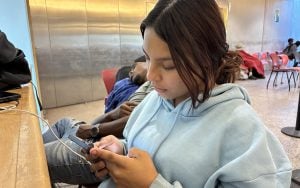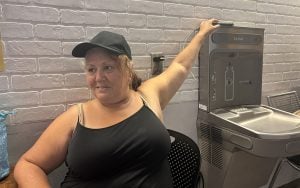
The Burton Barr Central Library respite center sign sits in the rejuvenating air conditioning as community members from downtown Phoenix run to its doors to escape the heat outside. (Photo by Jalen Woody/Cronkite News)
PHOENIX – In the middle of the desert, in Maricopa County, summer is the most brutal time. This year, temperatures reached 100 degrees or over for 142 days, according to the National Weather Service.
To combat heat struggles, the Maricopa Association of Governments (MAG) implemented a heat-relief network of centers to provide everyone with the care needed to brave some of the hottest temperatures in the United States.
Heat in the Phoenix metro is no joke, and many people have died from the blazing-hot temperatures, making this program vital for communities in Maricopa County. As of Oct. 12, 389 people have died from complications this year, according to the county.
As of Oct. 9, 35,309 people visited the respite and extended-hour cooling centers in Phoenix, according to a city report.

Jaqueline Lopez (blue hoodie) sits in the air-conditioned respite center at the Burton Barr Central Library as she scrolls through her phone. (Photo by Jalen Woody/Cronkite News)
MAG Human Services Planner Cleo Warner said the heat-relief centers are organized in four categories.
Cooling centers, Warner said, are air-conditioned spaces where volunteers and workers offer water. Respite centers are indoor, air-conditioned spaces with water and a place to rest and recuperate; they are equipped with a restroom, charging stations, food and medical checkups. Hydration stations can be indoor or outdoor stations that provide cool water. Collection and donation sites exist for the other centers that help them continue to provide care.
“They are really important to the community,” Warner said. “They are the backbone of our response every summer to the heat, and this is because they really are offering simple but key and extremely needed services for so many people. As our temperatures become dangerous, which they do every single year, without fail, they save countless lives.”
According to city of Chandler Community Resources Specialist and Heat Relief Coordinator Jeff Christian, the program is designed to be implemented when temperatures reach upwards of 100 degrees. The official timeline for the heat-relief network is from May to September. But given temperatures have remained above 100 degrees for most of October, heat-relief centers will remain open until Oct. 31, an entire month after the program was originally planned to end on Sept. 30.
The Burton Barr Respite Center was the only center remaining open 24 hours a day until Oct. 17. The 24-hour respite centers were implemented for the first time this year, Warner said.

The Burton Barr Central Library respite center sign sits in the rejuvenating air conditioning as community members from downtown Phoenix run to its doors to escape the heat outside. (Photo by Jalen Woody/Cronkite News)
“Getting those resources for the summer to run overnight sites is difficult, and it was amazing that we did have some partners step up this year to be able to do that,” Warner said earlier this month. “Our season normally runs May through September, and people allocate for resources and funds to be able to provide often voluntary work through those months. We are in this bonus extended period right now because the temperatures are so hot, and everyone is coming together to figure out how we can extend the season and extend those limited resources.”
Jaqueline Lopez slept at the Burton Barr Central Library respite center for the first two weeks of October. She said that she’s grateful for the respite center as it has been a safe haven for her in the heat.
“I’ve been through a lot. Got kicked out of my house, my family’s house at 16,” Lopez said. “I’m really glad (the temperatures are going down) because I’ll be able to be outside and walk around more.”
Lopez often walks around in the hot sun and found temporary shelter in the respite center at Burton Barr. She said she’s known about the respite centers for a while but only started taking advantage of the services this month. The respite center is located in the back of the library, and when the sun falls behind the building, more shade is available for people sitting inside and outside the center.

Monica Peña (black top) sits in the respite center away from the blazing hot temperatures in downtown Phoenix as she charges her phone. (Photo by Jalen Woody/Cronkite News)
The respite center itself is a small auxiliary room next to the back parking lot. Volunteers and workers for the city of Phoenix work in relaxed clothing as they tend to the needs of those checking into the respite center. The air is cool inside the room, air conditioning blasts into the room as patients walk and sit around, talk to volunteers, drink and eat food and water, charging their devices and resting.
In one corner of the room sits a woman named Monica Peña. Peña, a pastor, said she loves reaching out to people and helping them whenever she can. She enjoyed the convenience of the respite center and its 24-hour service.
“Respite centers and cooling centers are actually vital to the community whenever we’re trying to meet the needs of some of the most vulnerable, some of the most at-risk and often marginalized people that are in our city,” Christian said.
Many, he said, are often overlooked during the summer months, and these centers provide them a nice, cool place to find comfort in the blazing sun.
“Deaths are a real possibility, (and) we see it as vital to provide this service to people in our city, if this type of thing wasn’t available … there would be some pretty dire situations to arise that would be pretty horrific,” Christian said. “That would be pretty detrimental to the health and the life of some of the people that are most vulnerable in our community that we want to help and that we want to see their basic needs met.”

